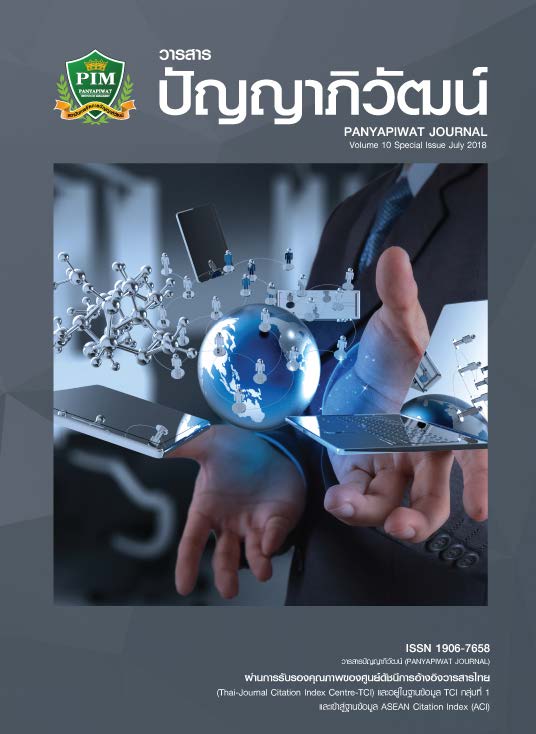ความผูกพันของพนักงานต่อองค์กรในกลุ่มธุรกิจเฟอร์นิเจอร์
Main Article Content
บทคัดย่อ
การวิจัยเรื่องความผูกพันของพนักงานต่อองค์กรในกลุ่มธุรกิจเฟอร์นิเจอร์นี้ ใช้วิธีการวิจัยเชิงปริมาณ กล่าวคือ ได้พัฒนาตัวแบบวิจัยขั้นต้นแล้วสร้างข้อคำถามที่ได้คุณภาพ เก็บข้อมูลโดยการสุ่มตัวอย่างในกลุ่มธุรกิจเฟอร์นิเจอร์แห่งหนึ่ง เพื่อทำการยืนยันตัวแบบในการวิจัย ซึ่งประกอบด้วย 3 ส่วนสำคัญคือ ส่วนที่ 1 ปัจจัยสร้างความผูกพันของพนักงานต่อองค์กร ประกอบด้วย 4 กลุ่มย่อยคือ ลักษณะงาน (Job Characteristics) บุคคลและสังคมในองค์กร (People and Social) ระบบองค์กร (Organization Practice) และสภาพแวดล้อมขององค์กร (Organization Climate) โดยแต่ละปัจจัยมีค่าน้ำหนักการเกิดความผูกพันของพนักงานต่อองค์กรเป็น .62, .70, .63 และ .76 ตามลำดับ ส่วนที่ 2 วัดระดับความผูกพันของพนักงานต่อองค์กรได้ที่ระดับร้อยละ 81.80 และส่วนที่ 3 ผลลัพธ์ของความผูกพัน โดยที่ในการทดสอบตัวแบบพบว่า ความผูกพันของพนักงานต่อองค์กรมีความสัมพันธ์กับผลงาน (Performance) ที่ระดับ .78 โดยที่การวัดผลงานทำได้ 3 ระดับคือ ระดับบุคคล (Individual Performance) ระดับทีม (Team Performance) และระดับองค์กร (Organization Performance) สำหรับกลุ่มธุรกิจเฟอร์นิเจอร์นี้นำข้อค้นพบผลการวิจัยไปใช้เป็นแนวทางในการสร้างความผูกพันได้ตามลำดับดังนี้ (1) พัฒนาระบบบริการภายใน (Internal Service) (2) พัฒนาระบบการบริหารผลงาน (Performance Management System) (3) พัฒนาโอกาสความก้าวหน้าในงาน Career Growth) (4) พัฒนาเครื่องมืออุปกรณ์ที่ใช้ในการทำงาน (Instrument) และ (5) กำหนดปริมาณงานที่เหมาะสมกับตำแหน่ง (Job Volume)
Article Details
“ข้าพเจ้าและผู้เขียนร่วม (ถ้ามี) ขอรับรองว่า บทความที่เสนอมานี้ยังไม่เคยได้รับการตีพิมพ์และไม่ได้อยู่ระหว่างกระบวนการพิจารณาลงตีพิมพ์ในวารสารหรือแหล่งเผยแพร่อื่นใด ข้าพเจ้าและผู้เขียนร่วมยอมรับหลักเกณฑ์การพิจารณาต้นฉบับ ทั้งยินยอมให้กองบรรณาธิการมีสิทธิ์พิจารณาและตรวจแก้ต้นฉบับได้ตามที่เห็นสมควร พร้อมนี้ขอมอบลิขสิทธิ์บทความที่ได้รับการตีพิมพ์ให้แก่สถาบันการจัดการปัญญาภิวัฒน์หากมีการฟ้องร้องเรื่องการละเมิดลิขสิทธิ์เกี่ยวกับภาพ กราฟ ข้อความส่วนใดส่วนหนึ่งและ/หรือข้อคิดเห็นที่ปรากฏในบทความข้าพเจ้าและผู้เขียนร่วมยินยอมรับผิดชอบแต่เพียงฝ่ายเดียว”
เอกสารอ้างอิง
AON Hewitt. (2015). Aon Hewitt’s Model of Employee Engagement. Retrieved August 7, 2017, from https://www.aonhewitt.co.nz/getattachment/77046028-9992-4d77-868a-32fbf622fec6/file.aspx?disposition=inline
AON Hewitt. (2017). Trends in Global Employee Engagement. Retrieved August 7, 2017, from https://www.aonhewitt.com.au/Home/Resources/Reports-and-research/2017-Trends-in-Global-Employee-Engagement-report
Balain, S. & Sparrow, P. (2009). Engaged to Perform: A New Perspective on Employee Engagement. Lancaster: Lancaster University Management School.
Bedarkar, M. & Pandita, D. (2014). A study on the drivers of employee engagement impacting employee performance. Social and Behavioral Sciences 133, 106-115.
Cook, S. (2008). The Essential Guide to Employee Engagement Better Business Performance through Staff Satisfaction. London and Philadelphia: Kogan Page.
Deloitte University. (2017). 2017 Human Capital Trends: A Government Perspective. Retrieved August 7, 2017, from https://www2.deloitte.com/content/dam/Deloitte/us/Documents/public-sector/us-fed-2017-government-hc-trends-supplement.pdf
Deloitte University. (2017). Rewriting the Rules for the digital age: 2017 Human Capital Trends.Retrieved August 7, 2017, from https://www2.deloitte.com/content/dam/Deloitte/us/Documents/human-capital/hc-2017-global-human-capital-trends-us.pdf
Development Dimension International. (2015). Employee Engagement: The Key to Realizing Competitive Advantage. Retrieved August 7, 2017, from www.ddiworld.com
Federman, B. (2009). Employee Engagement: A Roadmap for Creating Profits, Optimizing Performance, and Increasing Loyalty. San Francisco: John Wiley & Sons.
Hay Group. (2009). Engaging and Enabling Employees to Improve Performance outcomes. Retrieved August 7, 2017, from https://info-now.com/typo3conf/ext/p2wlib/pi1/press2web/html/userimg/EEA_EXPO_2010/Proceedings/SurveysandPolls-HayGroup-Agnew.pdf
Heskett, J. L., Sasser, W. E. Jr. & Wheeler, J. (2008). The Ownership Quotient: Putting the Service Profit Chain to Work for Unbeatable Competitive Advantage. Boston: Harvard Business School.
Macey, H. W., Schneider, B., Barbara, M. K. & Young, A. S. (2009). Employee Engagement. Oxford, UK: Wiley-Blackwell.
Robinson, D., Perryman, S. & Hayday, S. (2004). The Drivers of Employee Engagement. Retrieved August 7, 2017, from https://www.employment-studies.co.uk/system/files/resources/files/408.pdf
Robertson-Smith, G. & Markwick, C. (2009). Employee Engagement: A Review of Current Thinking. Retrieved August 7, 2017, from https://www.employment-studies.co.uk/system/files/resources/files/469.pdf
Suthammanon, L. (2017). Strategic Human Resource Management for Sustainable Organization. Bangkok:Chulalongkorn University. [in Thai]
The Federation of Thai Industries. (2011). Report on the analysis of the capabilities of the ASEAN Economic Community (AEC): Furniture industry. Retrieved August 7, 2017, from www.smi.or.th [in Thai]
Tirakanan, S. (2005). Research Methodology in Social Sciences: Practical approach. Bangkok: Book Center of Chulalongkorn University. [in Thai]
Willis Tower Watson. (2017). Finding from the 2016 Global Talent Management. New Jersey: Compensation Association.


